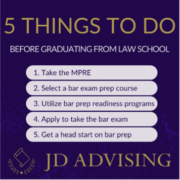How to Format a Closing Argument on the MPT
 How to Format a Closing Argument on the MPT
How to Format a Closing Argument on the MPT
We are starting an MPT (multistate performance test) series where we cover various “wildcard” tasks–e.g. the MPT tasks that are not tested often. The more you are familiar with the wildcard tasks, the less intimidated you will be if you see them on the MPT!Examinees were only asked to format a closing argument once on the MPT and that was in February 2011 in the Butler v. Hill MPT. Indeed, in that MPT, examinees were asked to write both an objective memorandum and a brief closing argument.
In that exam, both the objective memorandum and the brief closing argument were “short” and examinees were instructed to discuss specific issues in each. The National Conference of Bar Examiners (NCBE) could combine these two tasks together or they could simply instruct examinees to write a longer closing argument section.
On the February 2011 MPT, Examinees were asked to convince the court via the closing argument that (1) there was a valid marriage between the parties and (2) that the home was marital property and that the client was entitled to more than 50% of its value.
Examinees were specifically told to format the closing argument on the MPT as follows:
- (1) A brief introduction of the case;
- (2) Argument; and
- (3) Relief sought.
If you see a closing argument on the MPT, you will likely be instructed to format it in a similar manner. The important thing is that you pay close attention to the task memo.
Remember that the goal of an argument is to persuade.
Indeed, the Butler v. Hill MPT instructed examines to do all of the following:
- Tell a persuasive story about why the client should prevail (Note: This means that you should be recapping the facts in a persuasive way!);
- Highlight the evidence that the client intends to bring out at trial to support the factors enumerated in the statutes and case law (Note: This means you should apply the law to the facts in a persuasive way); and
- Address the other side’s position by showing how the evidence fails to support its case and in fact supports the client’s case instead. (Note: This means you should still address counterarguments, but show how they work in your favor! You should also state exactly what you want–the relief sought.)
The basic purpose of a closing argument is to be persuasive, highlight the key facts and law in support of your client, and minimize the arguments that the other side may have.
If you remember this general goal as well as the format listed above, you should do great on an MPT that requires a closing argument!
If you want to try writing a closing argument on the MPT, check out the February 2011 MPT of Butler v. Hill here.
Need Expert MPT Guidance?
🔥 Top-Rated MPT Resources
- New MPT One-Sheets: Discover crucial formats and tips distilled to simplicity.
- MPT Private Tutoring: Opt for personalized strategies and guidance to elevate your preparation.
- Bar Exam Crash Course and Mini Outlines: Gain a comprehensive understanding of the big picture.
- MPT Mastery Class: Deepen your understanding and skills for MPT excellence.
- Comprehensive MPT Guide: Navigate the MPT process with our step-by-step guide.
- Targeted MPT Feedback: Refine your approach with structural and organizational insights.
- Real MPT Questions Compilation (2000 to present): Engage in hands-on practice to enhance your readiness.
Plus, don’t miss our Free Bar Exam Resource Center filled with our top free resources and expert insights!
 Ashley Heidemann is the owner and founder of JD Advising. Ms. Heidemann scored over a 180 on the Michigan Bar Exam in February of 2011 after graduating as the #1 student in her law school class of over 200 students in 2011. She, as well as a team of others, offer bar exam courses, seminars, and private tutoring for bar exam students nationwide. This includes services for the Uniform Bar Exam (UBE) and Michigan bar exam. Please click here to contact her company, with any questions.
Ashley Heidemann is the owner and founder of JD Advising. Ms. Heidemann scored over a 180 on the Michigan Bar Exam in February of 2011 after graduating as the #1 student in her law school class of over 200 students in 2011. She, as well as a team of others, offer bar exam courses, seminars, and private tutoring for bar exam students nationwide. This includes services for the Uniform Bar Exam (UBE) and Michigan bar exam. Please click here to contact her company, with any questions.




Leave a Reply
Want to join the discussion?Feel free to contribute!